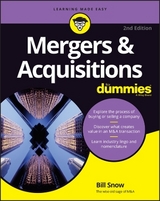
Mergers & Acquisitions For Dummies
For Dummies (Verlag)
978-1-119-54386-2 (ISBN)
- Titel erscheint in neuer Auflage
- Artikel merken
The easy way to make smart business transactions
Are you a business owner, investor, venture capitalist, or member of a private equity firm looking to grow your business by getting involved in a merger with, or acquisition of, another company? Are you looking for a plain-English guide to how mergers and acquisitions can affect your investments? Look no further.
Mergers & Acquisitions For Dummies explains the entire process step by step—from the different types of transactions and structures to raising funds and partnering. Plus, you'll get expert advice on identifying targets, business valuation, doing due diligence, closing the purchase agreement, and integrating new employees and new ways of doing business.
Step-by-step techniques and real-world advice for making successful mergers and acquisitions
Covers international laws and regulations
How to take advantage of high-value deals
Going beyond the case studies of other books, Mergers & Acquisitions For Dummies is your one-stop reference for making business growth a success.
Bill Snow is an authority on mergers and acquisitions. He has held leadership roles in public companies, venture-backed dotcoms, and angel funded start-ups. His perspective on corporate development gives him insight into the needs of business owners aiming to create value by selling or acquiring companies.
Introduction 1
About This Book 1
Conventions Used in This Book 2
What You’re Not to Read 3
Foolish Assumptions 3
How This Book Is Organized 4
Part 1: Mergers & Acquisitions 101 4
Part 2: Taking the First Steps to Buy or Sell a Company 4
Part 3: Starting the Deal on the Right Foot 4
Part 4: Firming Up the Deal 5
Part 5: Closing the Deal and Beyond! 5
Part 6: The Part of Tens 5
Icons Used in This Book 6
Where to Go from Here 6
Part 1: Mergers & Acquisitions 101 9
Chapter 1: The Building Blocks of Mergers and Acquisitions 11
Defining Mergers and Acquisitions 11
Introducing Important Terms and Phrases 12
Buyer 13
Seller 14
Transaction (also known as the deal) 16
Consideration 16
EBITDA 16
Adjusted EBITDA 17
Closing 17
Adhering to Basic M&A Rules and Decorum 18
Follow the steps to getting a deal done 18
Understand M&A etiquette 20
Know what to tell employees — and when 20
Considering the Costs Associated with M&A 21
Tallying advisors’ fees and other costs 22
Paying off debt 22
Post-closing adjustments 22
Sigh talking taxes 23
Determining What Kind of Company You Have 23
Sole proprietorship 24
Small business 25
Middle market and lower middle market company 25
Large company (and beyond) 25
Chapter 2: Getting Ready to Buy or Sell a Company 27
Considering Common Reasons to Sell 28
Retirement 28
Let someone else take the company to the next level 29
Divesting a division or product line 30
The industry is changing 31
I’ve got troubles, troubles, troubles 31
Selling a piece of the company 33
Planning Ahead to Ensure a Smooth Sale 35
Clean up the balance sheet 36
Pay off debt 37
Address legal issues 38
Trim staff and cut dead weight 38
Increase sales 39
Quantify owner’s expenses and other add backs 39
Owner, make thyself expendable 40
Exploring Typical Reasons to Acquire 41
Make more money 41
Gain access to new products and new markets 41
Implement vertical integration 41
Take advantage of economies of scale 42
Buy out a competitor 42
Prepping before an Acquisition 42
Determine the appropriate type of acquisition 42
Get your company’s balance sheet in order 42
Have the money lined up 43
Set up an acquisition chain of command 43
Buying a Company from a PE Firm 43
Understanding why PE firms sell 44
Evaluating a PE firm’s portfolio company 44
Chapter 3: Previewing the Generally Accepted M&A Process 45
Take Note! The M&A Process in a Nutshell 46
Step 1: Compile a target list 46
Step 2: Make contact with the targets 46
Step 3: Send or receive a teaser or executive summary 47
Step 4: Execute a confidentiality agreement 47
Step 5: Send or review the confidential information memorandum 47
Step 6: Solicit or submit an indication of interest 48
Step 7: Conduct management meetings 48
Step 8: Write or review the letter of intent 48
Step 9: Perform due diligence 49
Step 10: Draft the purchase agreement 49
Step 11: Show up for closing 49
Step 12: Deal with post-closing adjustments and integration 49
Exploring Two Types of M&A Processes: Auction versus Negotiation 50
Who Has It Easier, Buyer or Seller? 51
Selling is easy if you know what you’re doing 51
Buying is difficult even if you know what you’re doing 52
Following the Power Shifts in the M&A Process 53
Looking at the factors of motivation 54
Understanding who has power 55
Reading the other party’s situation 56
Maintaining as much power as possible when disclosing undesirable news 58
What to Tell Employees and When 58
Keep news of a sale process confidential 59
Never lie 59
A staggered release 59
Part 2: Taking the First Steps to Buy or Sell a Company 61
Chapter 4: Financing M&A Deals 63
Exploring Financing Options 63
Buyer uses his own cash 64
Buyer borrows money 65
Buyer utilizes Other People’s Money 65
Buyer seeks financial help from the Seller 66
Understanding the Levels of Debt 68
Surveying senior lenders and subordinated debt 68
Looking at lines of credit 68
Taking a Closer Look at Investors 69
Institutions versus individuals 69
Private equity (PE) firm 71
Strategic Buyer 73
Striking the Right Type of Deal 74
Exploring the differences among buyouts and majority and minority investments 74
Choosing an asset or a stock deal: What’s Buyer buying? 75
Examining the All-Important EBITDA 76
Making Buyers’ Return Calculations 77
Return on equity 77
Return on investment 77
Internal rate of return 78
Financing a Problem Child 78
Debt is greater than purchase price 78
The business has operating losses 79
Chapter 5: With a Little Help from Your Friends: Working with M&A Advisors 81
Choosing Wisely: Identifying Ideal Advisors 81
Utilizing Inside Advisors 83
CFO or other financial bigwig 84
Corporate development people 84
Hiring Outside Advisors 84
Consulting wealth advisors when you’re ready to sell 85
Considering an intermediary 86
Lawyering up on both sides 88
Looking at accountants and auditors for Buyers and Sellers 89
I’m the tax man! 89
Recruiting more consultants to Buyer’s team 90
Seeking friendly advice: Using friends and family as informal advisors 92
Skipping business appraisers 92
Keeping Everyone on the Same Page: Avoiding Communication Breakdowns 93
Getting Your Banker Involved 95
Chapter 6: Finding and Contacting Buyers or Sellers 97
Creating a Target List 97
Getting started 98
Expanding and winnowing the list 99
Capping the list: How many (and which) companies to include 101
Sellers on Your Mark: Contacting Buyers 103
Speaking with the right person 104
Following a script that works 107
Easy Does It: Contacting Sellers 110
Getting the call off on the right foot 111
Using a successful script 112
You’re having a serious conversation! What now? 113
Additional Tips for Getting Past Screeners 114
Recognizing who you’re dealing with 114
Overcoming screener roadblocks 115
Tracking Your Calls 118
Part 3: Starting the Deal on the Right Foot 121
Chapter 7: Assuring Confidentiality 123
Tempting Buyers with an Anonymous Teaser 123
Keeping it short and sweet 124
Including high-level financial info only 125
Touting key selling points 125
Executing a Confidentiality Agreement 126
Perusing the CA’s contents 126
Figuring out which party sends the CA 127
Determining who gets more value out of the CA 127
Handling a Breach of Confidentiality 128
Confirming a breach 129
Thinking long and hard about legal action 129
Keeping the Cat in the Bag: Advice for Buyers 130
Involving employees and advisors 130
Discussing the deal in public 130
Chapter 8: Creating and Reviewing an Offering Document 133
The Offering Document in a Nutshell 133
Compiling the Executive Summary 135
The thesis 135
Seller’s rationale for seeking a deal 140
Seller’s deal guidance 140
Presenting the Company’s Background 140
The company’s past and present 141
Ownership and legal entity 141
Employee info and benefits 142
Locations of offices and facilities 142
Real estate 143
Technology 143
Legal disclosures 143
Sharing the Go-to-Market Strategy 143
Description of market and products 144
Customer names 146
Info about competitors 146
Doing the Numbers 147
Historical financials 147
Financial projections 150
Balance sheet basics 150
Income statement basics 151
Losses on the books 153
Accounts receivable terms 153
Fixed assets (equipment) 154
Inventory 154
Intangible assets 154
Chapter 9: Properly Expressing Interest in Doing a Deal 157
Understanding the Indication of Interest 158
Including Key Bits of Information in an Indication of Interest 159
Preamble, platitudes, and Buyer background 160
The proposed deal: Valuation range and other considerations 160
The legalese 163
An enthusiastic send off 163
Chapter 10: Ensuring Successful First Meetings between Buyer and Seller 165
Understanding the Importance of Meeting in Person 166
The buyer gets to interact with key management 166
Both sides perform due diligence on the other 166
The parties gauge chemistry 167
Ironing Out Management Meeting Logistics 167
Assembling key players 168
Agreeing on a venue 168
Setting the meeting agenda 169
Perfecting the Seller’s Presentation 170
Gathering the right material 171
Making Seller’s presentation shine 171
Prepping Buyers for Management Meetings 172
Reading the Tea Leaves: Did the Meeting Go Well? 173
Part 4: Firming up the Deal 175
Chapter 11: An Insider’s Guide to M&A Negotiating 177
Keys to Negotiating Success 177
Know your position 178
Remember the goal: Closing a deal 178
Negotiate with the decision-maker 179
Bend where you can 180
Take it one day at a time 180
Remember your ABNs: Always be negotiating 180
Using Successful Negotiating Tactics 181
Say “Here’s the deal that gets it done” 181
Pick up the phone 181
Offer a conditional if-then agreement 182
Understand that the first who speaks loses 183
Don’t be afraid to haggle 183
Beware of a bad bluff 183
Avoiding Common M&A Negotiating Mistakes 184
Surviving Unforeseen Twists and Turns 186
Getting a deal gone sideways back on track 187
Negotiating in good faith 187
Chapter 12: Crunching the Numbers: Establishing Valuation and Selling Price 189
What’s a Company Worth? Determining Valuation 189
Meeting in the Middle: Agreeing on a Price 192
Testing the waters 192
Buyers: Measure returns 193
Sellers: Create a compelling valuation 194
When Buyer and Seller Disagree: Bridging a Valuation Gap 196
Using an earn-out to prove valuation 197
Settling a valuation disagreement with a Seller note 197
Paying for a company with stock 197
Selling less than 100 percent of the company 200
Dealing with Renegotiation 200
Chapter 13: LOI and Behold: Making or Receiving an Offer 203
Signaling Sincerity with a Letter of Intent 203
Understanding the Salient Issues in the LOI 205
Salutation and preamble 206
Valuation and deal structure 206
Holdback and escrow 207
Representations and warranties 207
Financing 208
Due diligence and timing 209
Approvals and conditions 209
Role of management 209
Access to information 209
Expenses 210
Exclusivity 210
Non-disclosure and publicity 210
Nonbinding agreement 211
Governing law or jurisdiction 211
Agreeing to and Extending Exclusivity 211
Considering exclusivity in pre-emptive bids 211
Running out of time: Prolonging exclusivity 212
You Have a Signed LOI — Now What? 213
Chapter 14: Confirming Everything! Doing Due Diligence 215
Digging into the Due Diligence Process 216
Getting the process underway 216
Allowing enough time for the due diligence phase 216
Covering the expense 217
Conveying the due diligence info to Buyer 218
Business as usual: Running the company during due diligence 218
Providing Appropriate Information 219
Corporate info 220
Operations 221
Financials 221
Sales and marketing info 222
Real estate and facilities info 223
Fixed assets 224
Inventory 224
Supplier info 225
Intellectual property 225
Human resources 226
Debt and financial dealings 226
Environmental concerns 227
Taxes 228
Contract information 228
Insurance 229
Litigation history 229
Governmental filings 231
Considering Requests for Additional Information 231
Chapter 15: Documenting the Final Deal: The Purchase Agreement 233
Drafting the Deal 234
Writing the first draft 234
Redlining the initial draft 235
Navigating the Final Purchase Agreement 235
Confirm the name, rank, and serial number of the deal 237
Determine what’s being sold, for how much, and when 237
Know what to bring to the closing 237
Review the representations and warranties 239
Secure against loss with indemnifications 243
Agree on how to handle a rep and warranty breach 244
Get acquainted with the exhibits and schedules 244
Part 5: Closing the Deal . . . and Beyond! 247
Chapter 16: Knowing What to Expect on Closing Day 249
Gathering the Necessary Parties 249
Walking Through the Closing Process 250
Reviewing the flow of funds statement 250
Signing the final purchase agreement and other documents 253
Distributing the funds: Show me the money! 254
Popping the champagne 254
Tying Up Loose Ends Shortly after Closing 255
Allowing time to fully close the books 255
Making a working capital adjustment 255
Chapter 17: Handling Post-Closing Announcements and Adjustments 257
Start Spreading the News 257
Telling Seller’s employees about the deal 258
Making a media announcement 259
Following Through: The Deal after the Deal 260
Closing the loop on post-closing adjustments 260
Wrapping up the contingent payments 261
Dealing with Disputes 262
Handling breaches 262
Making claims against escrow 264
Chapter 18: Come Together: Integrating Buyer and Seller 265
Planning the Integration 266
Assembling a Buyer’s transition team 266
Determining the level of autonomy 267
Covering the carve-out bases 267
Communicating with Seller before the close 268
Transition process: Planning the first 90 days 269
Culling Products and Services 271
Combining Operations, Administration, and Finance 272
Handling Personnel: Successful First Steps for New Owners 274
Addressing cultural differences 274
Resolving conflict 277
Acting like a leader at all times 279
Making friends 280
Instituting accountability 281
Firing people 282
Part 6: The Part of Tens 285
Chapter 19: Ten Considerations Prior to Signing an LOI 287
Is the Deal Too Good to Be True? 287
How Is the Buyer Financing the Deal? 288
How Much Cash Is in the Offer? 288
What Are the Conditions of Escrow? 288
Is the Deal a Stock or Asset Deal? 288
How Does the Deal Settle Working Capital Issues Post-Closing? 289
Is the Inventory 100 Percent Salable? 289
Who Pays Off Any Long-Term Debt and What Happens to the Line of Credit? 290
What Are the Tax Implications of the Seller’s Accounts Receivable? 290
Is the Seller Signing a Noncompete Agreement with the Buyer? 290
Chapter 20: Ten Major M&A Errors and How to Avoid Them 291
Assuming the Deal Is Done after the LOI Stage 291
Being Unprepared for Due Diligence 292
Asking for a High Valuation with No Rationale 292
Figuring Buyers Won’t Discover Problems in the Financials 292
Underestimating the Other Side’s Sophistication 293
Failing to Understand Who Really Has the Power 293
Withholding Material Information 293
Blabbing about the Deal Before It Closes 294
Calling the Seller’s Employees without Permission 294
Contacting a Seller’s Customers or Vendors without Authorization 294
Chapter 21: Ten Possible Ways to Solve Valuation Differences 297
Payments over Time 297
Earn-Out Based on Revenues 298
Earn-Out Based on Earnings 298
Earn-Out Based on Gross Profit 299
Valuation Based on a Future Year 299
Partial Buyout 299
Stock and Stock Options 300
Consulting Contract 300
Stay Bonus 300
Combo Package 301
Appendix 303
Index 333
| Erscheinungsdatum | 19.09.2018 |
|---|---|
| Sprache | englisch |
| Maße | 185 x 231 mm |
| Gewicht | 590 g |
| Themenwelt | Wirtschaft ► Betriebswirtschaft / Management ► Planung / Organisation |
| ISBN-10 | 1-119-54386-X / 111954386X |
| ISBN-13 | 978-1-119-54386-2 / 9781119543862 |
| Zustand | Neuware |
| Haben Sie eine Frage zum Produkt? |
aus dem Bereich



